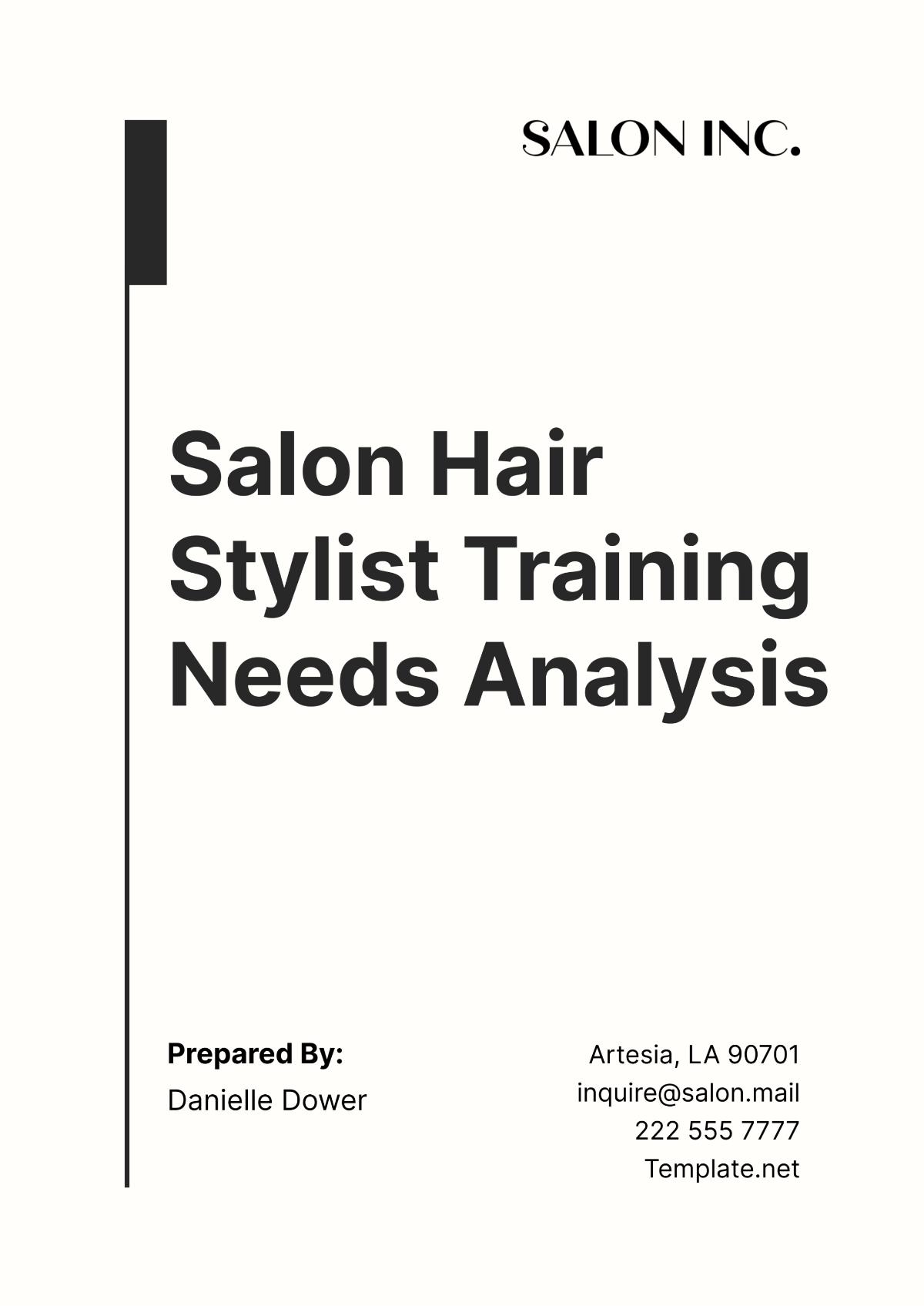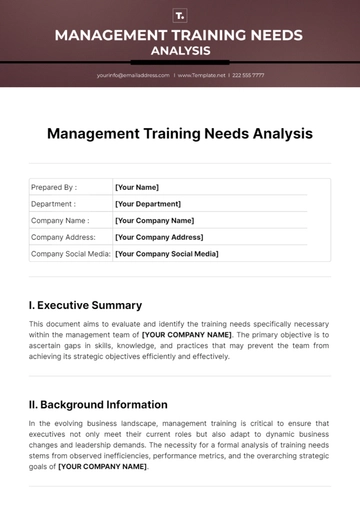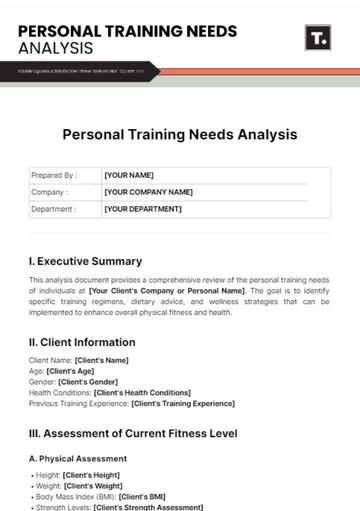Free Salon Hair Stylist Training Needs Analysis

I. Introduction
A. Purpose
The purpose of this document is to conduct a comprehensive Training Needs Analysis (TNA) for Salon Hair Stylists at [Your Company Name], with the aim of identifying skill gaps and training requirements to enhance the overall quality of services provided by our stylists.
B. Scope
This TNA will focus on evaluating the current skill levels, knowledge, and areas of improvement for Salon Hair Stylists employed at [Your Company Name].
C. Background
[Your Company Name] is a leading salon chain dedicated to providing top-notch hair care and styling services to our valued clients. With a team of talented Salon Hair Stylists, we have built a reputation for excellence and innovation in the beauty industry. As part of our commitment to continuous improvement and professional development, it is imperative to assess the training needs of our Salon Hair Stylists periodically. By identifying areas for improvement and providing targeted training interventions, we aim to elevate the skill levels and expertise of our stylists, thereby enhancing the overall salon experience for our clientele.
II. Methodology
A. Data Collection Methods
Surveys: Conduct surveys among Salon Hair Stylists to gather insights into their perceived training needs and areas for improvement. Surveys will include questions regarding current skill levels, preferred training topics, and feedback on existing training programs.
Performance Reviews: Review performance evaluations of Salon Hair Stylists conducted by salon managers or supervisors. Performance reviews will assess key performance indicators such as client satisfaction, service quality, and adherence to salon protocols.
Client Feedback: Analyze client feedback collected through various channels such as satisfaction surveys, online reviews, and direct interactions. Client feedback will provide valuable insights into areas where Salon Hair Stylists excel and areas where improvement is needed.
Observation: Observe Salon Hair Stylists in action during their daily tasks, including client consultations, hair styling, and customer interactions. Observations will help assess practical skills, customer service demeanor, and adherence to salon standards.
Industry Trends Analysis: Research industry trends and best practices in hair care and styling to identify emerging skill requirements and training opportunities. Industry trend analysis will ensure that our training programs remain relevant and aligned with industry standards.
B. Data Analysis
Quantitative Analysis: Utilize statistical methods to analyze survey data and performance metrics collected from surveys and performance reviews. Quantitative analysis will involve calculating averages, frequencies, and correlations to identify patterns and trends in the data.
Qualitative Analysis: Conduct thematic analysis of open-ended survey responses and qualitative feedback from client interactions and observations. Qualitative analysis will involve identifying recurring themes, sentiments, and specific examples to supplement quantitative findings.
Gap Identification: Identify gaps between the current skill levels of Salon Hair Stylists and the desired competencies outlined by [Your Company Name]. Gaps will be identified based on discrepancies between perceived training needs and existing skill sets, as well as discrepancies between client expectations and actual service delivery.
C. Data Sources and Sample Sizes
Data Source | Sample Size |
|---|---|
Salon Hair Stylist Surveys | [50] |
Performance Reviews | [100] |
Client Feedback | [500] |
Observation Sessions | [20] |
Industry Trend Analysis | N/A |
Note: Sample sizes are approximate and may vary based on the number of Salon Hair Stylists employed at [Your Company Name] and the availability of data for analysis.
III. Findings
A. Skill Gaps
Hair Cutting and Styling Techniques
While many Salon Hair Stylists demonstrate proficiency in basic cutting and styling techniques, there is a need for further training in advanced techniques such as layering, texturizing, and precision cutting.
Color Theory and Application
Some Salon Hair Stylists lack confidence and expertise in color theory and application, particularly when it comes to complex color correction procedures and achieving desired color results for clients.
Product Knowledge and Recommendations
While Salon Hair Stylists are familiar with basic hair care products, there is a need for deeper knowledge and understanding of specialized products such as hair treatments, styling tools, and professional-grade color lines.
Client Consultation and Communication
Certain Salon Hair Stylists struggle with effective client consultation techniques, including active listening, interpreting client preferences, and articulating recommendations in a clear and concise manner.
Time Management and Workflow Optimization
Many Salon Hair Stylists face challenges in managing their time effectively during busy salon hours, resulting in delays in appointments and reduced overall productivity.
B. Training Needs
Advanced Hair Cutting and Styling Techniques
Hands-on workshops and demonstrations focusing on advanced cutting and styling techniques, including razor cutting, precision bobs, and creative updos.
Color Theory and Application
In-depth seminars and practical sessions covering advanced color theory, color wheel concepts, corrective color techniques, and color formulation.
Product Knowledge and Recommendations
Training sessions conducted by product suppliers and industry experts to educate Salon Hair Stylists on the features, benefits, and proper usage of salon products and tools.
Client Consultation and Communication
Communication skills workshops focusing on active listening, effective questioning techniques, empathy, and building rapport with clients to enhance the consultation process.
Time Management and Workflow Optimization
Time management seminars and workshops offering strategies and tools for prioritizing tasks, managing client appointments, and streamlining salon workflows for maximum efficiency.
IV. Training Plan
A. Objectives
Enhance proficiency in hair cutting and styling techniques to meet diverse client needs and preferences.
Develop advanced color theory knowledge and application skills to achieve desired color results and address client concerns effectively.
Deepen product knowledge to recommend suitable hair care products and tools for client-specific needs and styling goals.
Improve communication skills to engage effectively with clients during consultations, build trust, and convey recommendations clearly.
Implement time management strategies to optimize salon workflows, minimize appointment delays, and maximize productivity during peak hours.
B. Training Modules
Training Module | Description |
|---|---|
Advanced Hair Cutting and Styling Techniques | Hands-on workshops and demonstrations covering advanced cutting, texturizing, and styling techniques. |
Color Theory and Application | In-depth seminars and practical sessions on color theory, formulation, and advanced color techniques. |
Product Knowledge and Recommendations | Training sessions led by product suppliers to educate stylists on the features and benefits of salon products. |
Client Consultation and Communication | Communication skills workshops focusing on active listening, empathy, and effective client communication. |
Time Management and Workflow Optimization | Workshops offering strategies and tools for optimizing time management and salon workflow efficiency. |
Note: Training modules will be delivered through a combination of in-person workshops, online courses, and self-paced learning materials to accommodate diverse learning preferences and scheduling constraints.
V. Implementation Plan
A. Timeline
Identify Training Dates and Schedule Sessions
Review availability of Salon Hair Stylists and schedule training sessions accordingly, taking into account peak salon hours and staffing constraints.
Communicate Training Plan to Salon Hair Stylists
Send out communication via email and team meetings to inform Salon Hair Stylists about the upcoming training plan, including dates, times, and objectives of each session.
Procure Necessary Training Materials and Resources
Identify and procure training materials, equipment, and resources required for each training module, such as hair styling tools, color swatches, product samples, and training manuals.
Conduct Training Sessions as per Schedule
Facilitate training sessions according to the established schedule, ensuring adequate time for hands-on practice, discussions, and feedback sessions.
B. Resource Allocation
Allocate Budget for Training Programs
Allocate funds for training programs, including venue rental, trainer fees, training materials, and other related expenses.
Assign Trainers and Facilitators for Each Module
Identify qualified trainers and facilitators for each training module, ensuring expertise in the respective subject matter and effective delivery of training content.
Arrange Venue and Equipment for Training Sessions
Secure suitable venues for training sessions, equipped with necessary facilities such as styling stations, presentation equipment, and audiovisual aids.
Provide Support and Assistance to Salon Hair Stylists During Training
Offer guidance, support, and assistance to Salon Hair Stylists throughout the training process, addressing any questions, concerns, or technical issues that may arise.
VI. Evaluation
A. Metrics
Pre-Training Assessments to Measure Baseline Competencies
Conduct pre-training assessments to evaluate the baseline competencies of Salon Hair Stylists in key areas such as cutting techniques, color application, product knowledge, communication skills, and time management.
Post-Training Evaluations to Assess Skill Improvement
Administer post-training evaluations to assess the effectiveness of training interventions in enhancing Salon Hair Stylists' skills, knowledge, and confidence levels.
Client Feedback on Service Quality and Satisfaction Levels
Solicit feedback from clients regarding the quality of services provided by Salon Hair Stylists post-training, measuring satisfaction levels, perceived improvements, and areas for further enhancement.
B. Continuous Improvement
Review Training Effectiveness Based on Post-Training Evaluations
Analyze post-training evaluation data to identify areas of strength and improvement opportunities in the training programs, adjusting future training plans accordingly.
Solicit Feedback from Salon Hair Stylists for Program Enhancement
Gather feedback from Salon Hair Stylists regarding their training experience, including feedback on training content, delivery methods, and overall effectiveness
Stay Updated on Industry Trends and Best Practices for Ongoing Training Updates
Monitor industry trends, advancements, and best practices in hair care and styling to inform future training initiatives and ensure alignment with industry standards and client expectations.
VII. Conclusion
A. Summary of Key Findings
Identified skill gaps and training needs for Salon Hair Stylists through a comprehensive Training Needs Analysis process.
Developed a targeted training plan to address identified areas of improvement and enhance the overall skills and competencies of our Salon Hair Stylists.
B. Next Steps
Implement Training Plan According to Timeline and Resource Allocation.
Initiate the implementation of the training plan as per the established timeline, ensuring adherence to allocated resources and schedule.
Monitor and Evaluate Training Effectiveness.
Monitor the progress and effectiveness of training interventions through ongoing assessments, evaluations, and feedback mechanisms.
Continuously Improve Training Programs Based on Feedback and Industry Trends.
Iterate and enhance training programs based on feedback from Salon Hair Stylists, client satisfaction levels, and evolving industry trends and best practices.
C. Acknowledgments
[Your Company Name] extends its sincere appreciation to all Salon Hair Stylists who participated in the Training Needs Analysis process and contributed valuable insights and feedback.
Special thanks to the training facilitators, support staff, and stakeholders involved in the planning, development, and execution of the training initiatives.
- 100% Customizable, free editor
- Access 1 Million+ Templates, photo’s & graphics
- Download or share as a template
- Click and replace photos, graphics, text, backgrounds
- Resize, crop, AI write & more
- Access advanced editor
Assess hair stylist training needs effectively with Template.net's Salon Hair Stylist Training Needs Analysis Template. This customizable document provides a structured format for identifying training requirements and skill development opportunities for hair stylists in your salon. Ensure continuous professional growth and quality service delivery. Editable in our Ai Editor Tool for seamless customization and integration into your salon's training programs.
















